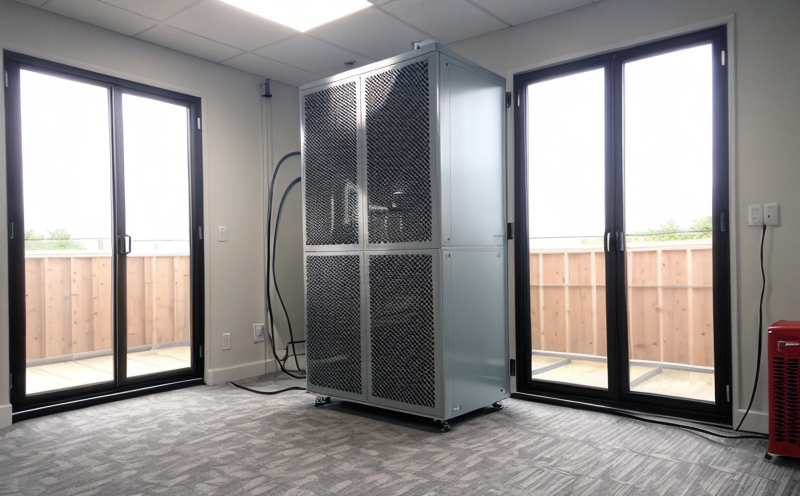EN 13053 AHU Airflow Performance Verification
The European Standard EN 13053 specifies the methods and procedures to verify the airflow performance of air handling units (AHUs) in HVAC systems. This standard ensures that the actual airflow delivered by an air handling unit meets the design specifications, thereby guaranteeing optimal indoor air quality, energy efficiency, and compliance with relevant regulations.
Airflow verification is critical for several reasons:
- Ensures that the AHU operates within its intended parameters,
- Guarantees accurate delivery of conditioned air to the spaces it serves,
- Prevents energy waste due to oversized or undersized fans,
- Achieves compliance with local and international standards.
The testing process involves several key steps. Initially, the AHU is calibrated using precision instruments like flow meters and pressure gauges to establish a baseline reading. The test setup includes monitoring points at various locations within the air distribution system to capture airflow data accurately. Once collected, this data is analyzed against the design specifications provided by the manufacturer or engineer.
During testing, it’s important to consider factors such as fan speed, static pressure, and temperature variations. These elements directly impact the overall performance of the AHU. For instance, if a fan runs at an excessively high speed, it may consume more energy than necessary while still delivering less airflow than required. By verifying airflow according to EN 13053, we can ensure that these variables are optimized for maximum efficiency.
The standard also covers additional aspects like ductwork integrity checks and filter performance evaluations. Duct leakage is another critical factor; even small leaks can significantly affect the overall system performance. Thus, ensuring tight joints and proper sealing of all components during testing helps maintain optimal airflow distribution throughout the building.
Another essential aspect of EN 13053 compliance involves regular audits over time to track changes in equipment efficiency due to wear and tear or other factors. Regular verification allows for timely maintenance interventions before issues escalate into larger problems, potentially saving significant costs in the long run. Additionally, it supports continuous improvement initiatives aimed at enhancing operational effectiveness.
For quality managers and compliance officers responsible for HVAC systems, adhering to standards like EN 13053 ensures consistent performance across all installations. This consistency not only enhances occupant comfort but also contributes positively towards achieving broader sustainability goals within organizations.
By incorporating advanced testing methodologies into your maintenance protocols, you can significantly extend the lifespan of your HVAC equipment and reduce operational expenses. Investing in regular verification based on EN 13053 will provide peace of mind knowing that every component is functioning correctly according to specifications.
Benefits
Adopting EN 13053 AHU Airflow Performance Verification offers numerous advantages:
- Enhanced Indoor Air Quality: Ensures that the air flowing into occupied spaces meets health and safety standards.
- Better Energy Efficiency: Identifies inefficiencies early, allowing for corrective actions to be taken promptly.
- Compliance with Regulations: Helps organizations remain compliant with relevant regulatory requirements.
- Reduction in Operational Costs: By optimizing fan speeds and reducing energy consumption without compromising air quality or comfort levels.
- Extended Equipment Lifespan: Regular verification helps identify potential issues early, preventing premature failures and costly replacements.
- Improved Occupant Comfort: Ensures consistent delivery of conditioned air to all areas served by the AHU.
- Sustainability Initiatives Support: Plays a crucial role in meeting sustainability targets set by organizations or governments.
In summary, implementing EN 13053 AHU Airflow Performance Verification is not just about meeting regulatory requirements; it’s also about ensuring long-term operational effectiveness and sustainability. It provides a robust framework for maintaining high standards of performance across all HVAC installations within an organization.
Industry Applications
The application of EN 13053 AHU Airflow Performance Verification extends beyond individual buildings to encompass various industries where efficient and reliable HVAC systems play a pivotal role. Here are some key sectors that benefit from this standard:
- Commercial Buildings: Ensures optimal air distribution in large office complexes, retail stores, hotels, and other commercial establishments.
- Healthcare Facilities: Guarantees stringent air quality standards necessary for patient care environments.
- Education Institutions: Supports the creation of comfortable learning spaces while ensuring good indoor air quality.
- Data Centers: Maintains critical environmental conditions essential for server operations and data integrity.
- Transportation Infrastructure: Ensures comfort and safety in train stations, airports, and other public transport facilities.
- Residential Developments: Enhances home quality standards by providing healthier living environments through precise airflow management.
In each of these sectors, maintaining proper airflow is crucial for operational efficiency, occupant well-being, and regulatory compliance. Therefore, adhering to EN 13053 ensures that HVAC systems function optimally across diverse applications.
Environmental and Sustainability Contributions
Adhering to EN 13053 AHU Airflow Performance Verification contributes significantly to environmental protection and sustainability efforts:
- Energy Savings: By optimizing fan speeds based on actual airflow needs, significant reductions in energy consumption are achieved.
- Reduced Carbon Footprint: Lowering energy usage directly translates into reduced greenhouse gas emissions from power generation sources.
- Material Resource Efficiency: Proper operation minimizes unnecessary wear and tear on components, extending their useful life and reducing waste.
- Water Conservation: Efficient systems contribute to better management of water resources by preventing leaks that could lead to wastage.
- Biodiversity Protection: Cleaner air contributes positively towards preserving natural ecosystems and biodiversity.
- Social Responsibility: Ensuring safe working environments supports social responsibility initiatives within organizations.
Overall, compliance with EN 13053 plays a vital role in promoting sustainable practices that benefit both the environment and society as a whole.





